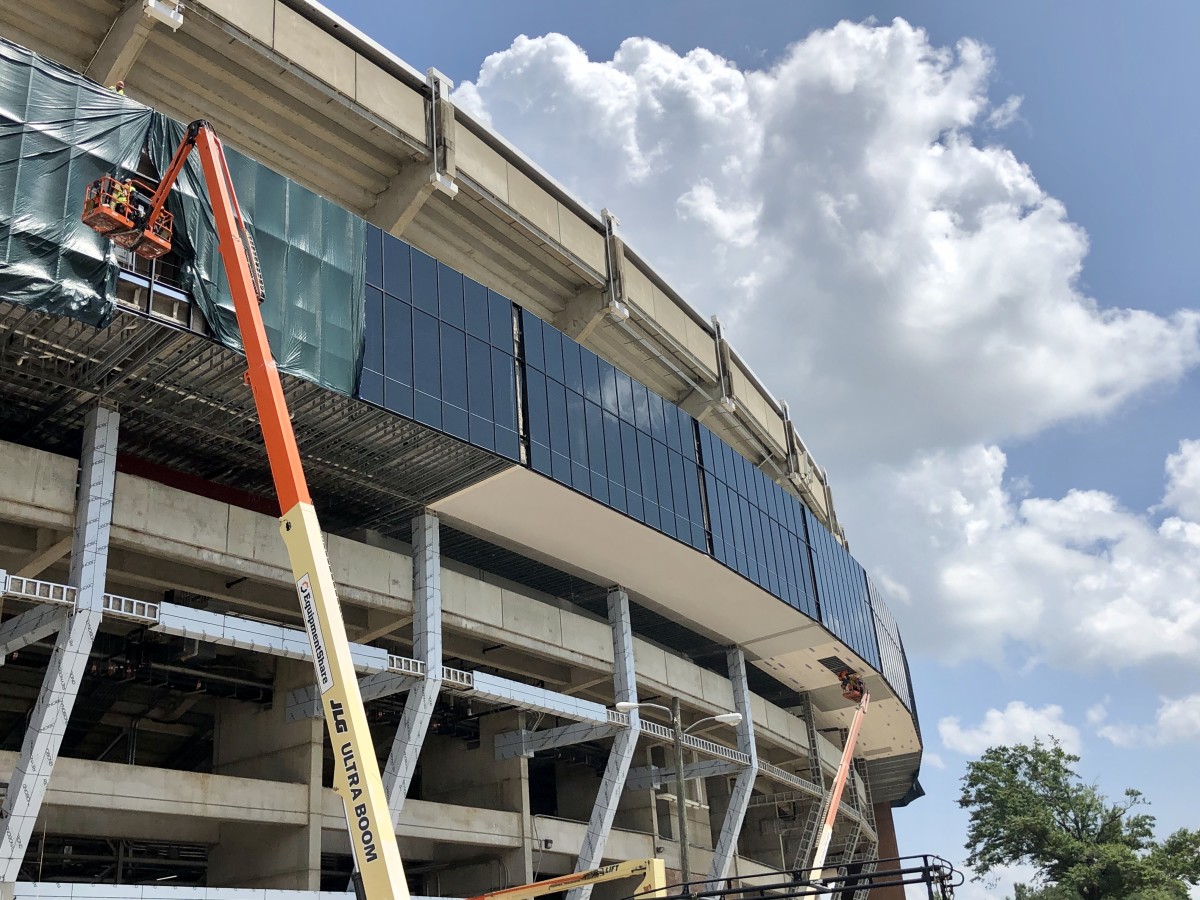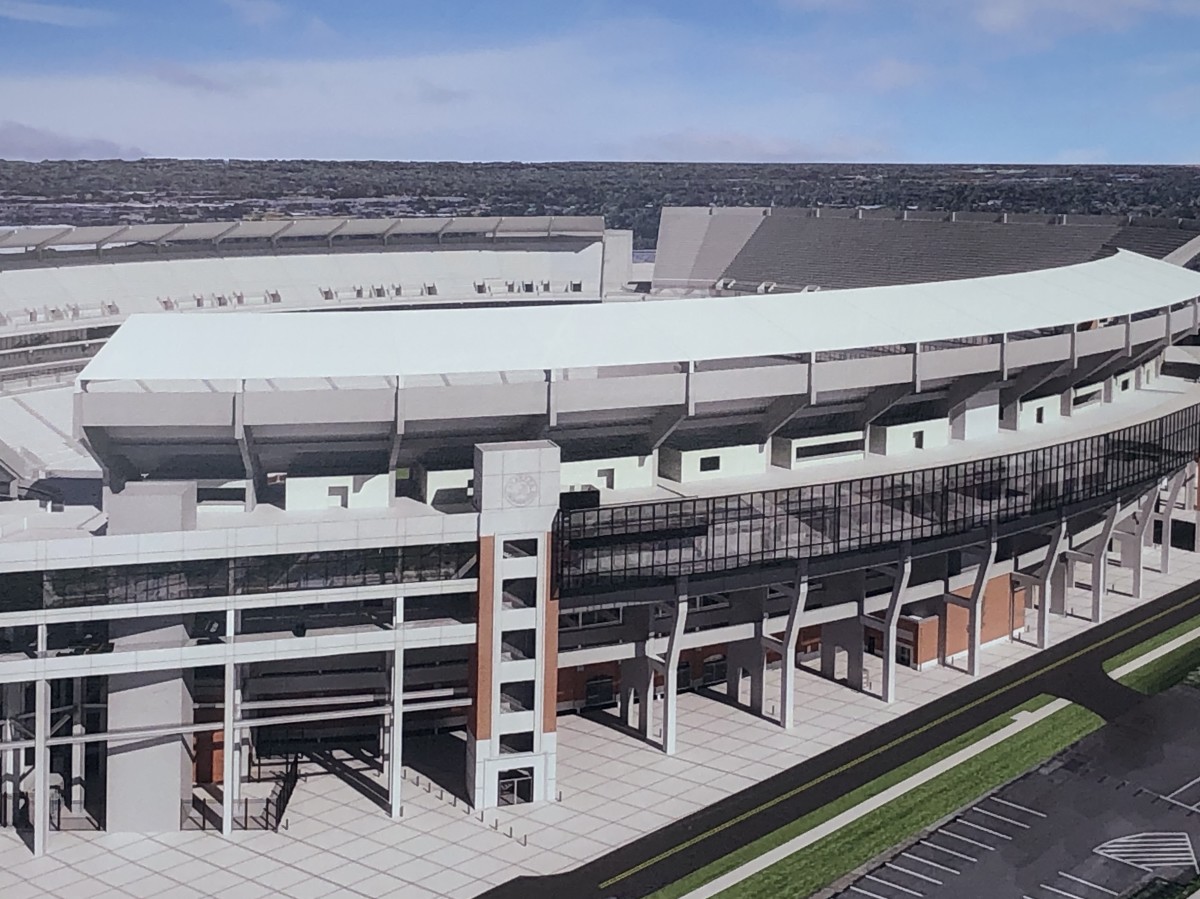This Isn't Your Parents' Bryant-Denny Stadium
The tunnel has been dug and the next concrete set. The new luxury boxes are structurally coming into place. The new video boards are set.
With roughly two months to go, work on the $107 million renovation of Bryant-Denny Stadium continues. Even though there have been reports of construction workers testing positive for the coronavirus, the project is still churning toward the home opener against Georgia State on Sept. 12.
Actually, it's only the first of two projects planned for the stadium, which were paired as the bookends to the Crimson Standard, a 10-year $600 million capital initiative to improve Alabama's athletic facilities formally unveiled on August 16, 2018.
Phase one includes new luxury seating (and moving the press box from the 50-yard line), a tunnel going from the Walk of Champions directly into the Crimson Tide locker room, and new video boards.
The final phase will upgrade the fan amenities and and widen the concourses, in an effort to make physical atmosphere more on par of an NFL stadium.
Last year Alabama installed a new LED light system, but then had to to wait for the Third Saturday in October (Tennessee rivalry) to enjoy it as TV kept scheduling afternoon kickoffs at the 101,821-seat stadium.
But even before all that, Bryant-Denny Stadium was already one of unique experiences in all of sports.
Where else can one see:
• Flags for 17 national championships snapping in the wind?
• Watch fans point out recruits by name like they’re long lost friends?
• Hear a sellout crowd go nuts every time they show Paul W. “Bear” Bryant's gravely voice proclaiming “I ain’t nothin’ but a winner.”
Prior to the stadium, Alabama played on campus at the Quad, first on the southeast corner with the field running parallel to what’s now 6th Avenue, until the turn of the century when the field was turned 90 degrees to the west to run parallel to University Boulevard.
In 1915, games were played on University Field, renamed Denny Field in 1920, where the Tide played for 14 years. It was located two blocks east of the current stadium, behind Little Hall. Mallet Hall and Parker-Adams Hall now stand on what used to be the north end zone, and a parking lot covers what was the rest of the field.
Overall, Alabama was 44-9 in those locations, and opponents were scoreless in 35 of the 45 games played at Denny Field.
With university president Dr. George Hutcheson Denny using football as a means to promote and build up the school, upgrading the facilities was an obvious priority even though the team played at least one home game a year in Birmingham.
The stadium opened Sept. 8, 1929, with a 55-0 victory against Mississippi College, and was officially dedicated a week later during homecoming by Gov. Bibb Graves. Initial seating capacity was 12,000. It wasn’t until 1975 that the state legislature renamed the facility Bryant-Denny Stadium.

There have been numerous improvements and expansion projects since it opened, including the following:
1937: The first stadium expansion added 6,000 seats to the east side.
1946: Bleachers were constructed behind both end zones, bringing capacity up to 31,000.
1961: Another 12,000 seats were added, along with a press box and elevator. With the lower bowl nearly closed in, capacity reached 43,000.
1966: The lower bowl was enclosed with seating expansion bringing capacity up to 60,000.
1988: The western upper deck was completed adding another 10,000 seats, for a 70,123 total.
1998: The eastern upper deck was added along with two rows of skyboxes, bringing capacity more in line with that of other Southeastern Conference home stadiums, 83,818. Four additional skyboxes were built in 1999, bringing the total to 85.
2006: The north end-zone addition added a club level, skyboxes, upper-deck seating and a courtyard. The project, which cost approximately $50 million, brought the total number of skyboxes up to 123 and capacity reached 92,138. Additionally, three new video scoreboards were added, along with state-of-the-art ribbon wrap-around display boards on the facades of the east and west upper deck.
2010: A $65 million expansion of the South End Zone filled in the last upper deck, and increased seating capacity to 101,821. Along with the 34 added skyboxes, bringing the stadium total to 157, another Zone club just like the original on the North side was added along with a new Stadium Club. Two new scoreboards were installed in the corners along with a new sound system, and the outside along Bryant Drive was given a brick exterior to better blend in with the rest of campus.
With nearly every game since 1988 having been sold out, and university enrollment growing from roughly 20,000 to 38,000-plus over the past 20 years, the number of student tickets was initially increased by 2,000, up to 17,000, giving Alabama the highest percentage of student-available seating among major programs at 59 percent.
“We are fortunate to play our home games in one of the finest football facilities in the nation,” director of athletics Mal Moore said. “Our fans enjoy fantastic campus activities prior to the game and then move into a state-of-the-art facility to watch the game. The atmosphere is second-to-none.”

Bryant-Denny Stadium Capacity
Year, Total
1929 12,000
1946 31,000
1961 43,000
1966 60,000
1988 70,123
1998 83,818
2006 92,138
2010: 101,821
